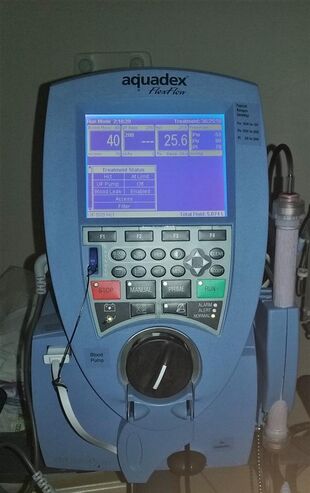Medicine:Aquapheresis
From HandWiki
| Aquapheresis | |
|---|---|
 Dark Aquapheresis machine at work | |
| ICD-9 | 99.78 |
Aquapheresis is a medical technology designed to remove excess salt and water from the body safely, predictably, and effectively from patients with a condition called fluid overload. It removes the excess salt and water and helps to restore a patient's proper fluid balance, which is called euvolemia.
Uses
Aquapheresis is used to treat a condition called fluid overload or hypervolemia. Fluid overload can be caused by many reasons, including heart failure, liver cirrhosis, hypertension and certain kidney diseases. Fluid overload can also be experienced after certain surgical operations. Congestive heart failure is the most common reason for fluid overload.
How it works
- Blood containing excess salt and water is withdrawn from a patient using peripheral or central venous catheters and passed through a special filter. Using a form of ultrafiltration, the filter separates the excess salt and water from the blood and the blood is returned to the patient while the fluid is collected in a bag for later disposal.
- Anti-coagulation therapy is often used with aquapheresis to prevent blood from clotting the ultrafiltration filter. Patients must discontinue any anticoagulant medications before starting aquapheresis so they can be placed on intravenous heparin therapy. Once the Heparin therapy is initiated, the patient's PTT (partial thromboplastin time) levels will be monitored closely per hospital protocol to prevent excessive anti-coagulation. If a patient is allergic to Heparin or has a condition known as Heparin-induced Thrombocytopenia (HIT), an alternative intravenous anti-coagulate may be used.
- The blood is outside the body for less than a minute and the total amount of blood is 33 milliliters (2.5 tablespoons). It is thus an extracorporeal therapy.
- Up to a 500 milliliter (1 pint) of excess fluid can be removed per hour. The average removal rate is 250 milliliter (1/2 pint) per hour.
- The fluid removed is isotonic to blood and therefore electrolyte balance is maintained throughout therapy and up to 3.2 grams of sodium per liter can be removed.
- Aquapheresis therapy is delivered by three basic components: a console (the machine with two pumps), the blood filter circuit, and the venous catheter(s).
See also
- Fluid balance
- Fluid overload
- Blood volume
- Diuretics
- Apheresis
- Congestive Heart Failure
- Hypervolemia
- Ultrafiltration (renal)
- Ultrafiltration
References
- "Ultrafiltration versus intravenous diuretics for patients hospitalized for acute decompensated heart failure". J Am Coll Cardiol 49 (6): 675–83. Feb 2007. doi:10.1016/j.jacc.2006.07.073. PMID 17291932.
- "Ultrafiltration is Associated With Fewer Rehospitalizations than Continuous Diuretic Infusion in Patients With Decompensated Heart Failure: Results From UNLOAD". J Card Fail 16 (4): 277–84. 2010. doi:10.1016/j.cardfail.2009.12.009. PMID 20350693.
- "Early ultrafiltration in patients with decompensated heart failure and diuretic resistance". J Am Coll Cardiol 46 (11): 2047–51. Dec 2005. doi:10.1016/j.jacc.2005.05.099. PMID 16325040.
- "Ultrafiltration versus usual care for hospitalized patients with heart failure: the Relief for Acutely Fluid-Overloaded Patients With Decompensated Congestive Heart Failure (RAPID-CHF) trial". J Am Coll Cardiol 46 (11): 2043–6. Dec 2005. doi:10.1016/j.jacc.2005.05.098. PMID 16325039.
- "Peripherally inserted veno-venous ultrafiltration for rapid treatment of volume overloaded patients". Journal of Cardiac Failure 9 (3): 227–31. Jun 2003. doi:10.1054/jcaf.2003.28. PMID 12815573.
- "Circulatory response to fluid overload removal by extracorporeal ultrafiltration in refractory congestive heart failure". J Am Coll Cardiol 38 (4): 963–8. Oct 2001. doi:10.1016/S0735-1097(01)01479-6. PMID 11583865.
- "Sustained improvement in functional capacity after removal of body fluid with isolated ultrafiltration in chronic cardiac insufficiency: failure of furosemide to provide the same result". Am J Med 96 (3): 191–9. Mar 1994. doi:10.1016/0002-9343(94)90142-2. PMID 8154506.
- "Sustained cardiac diastolic changes elicited by ultrafiltration in patients with moderate congestive heart failure: pathophysiological correlates". Br. Heart J. 70 (2): 135–40. Aug 1993. doi:10.1136/hrt.70.2.135. PMID 8038023.
- "Isolated ultrafiltration in moderate congestive heart failure". J Am Coll Cardiol 21 (2): 424–31. Feb 1993. doi:10.1016/0735-1097(93)90685-T. PMID 8426008.
- S. A. Hunt et al. (2009). "2009 Focused Update Incorporated Into the ACC/AHA 2005 Guidelines for the Diagnosis and Management of Heart Failure in Adults: A Report of the American College of Cardiology Foundation / American Heart Association Task Force on Practice Guidelines: Developed in Collaboration With the International Society for Heart and Lung Transplantation". Circulation 119 (14): e391–e479. doi:10.1161/CIRCULATIONAHA.109.192065. PMID 19324966.
- "Executive Summary: HFSA 2010 Comprehensive Heart Failure Practice Guideline". J Card Fail 16 (6): 475–539. 2010. doi:10.1016/j.cardfail.2010.04.005. PMID 20610207. http://www.heartfailureguideline.org/.
- Kenneth Dickstein; Alain Cohen-Solal; Gerasimos Filippatos; John J.V. McMurray; Piotr Ponikowski; Philip Alexander Poole-Wilson; Anna Stromberg; Dirk J. van Veldhuisen et al. (2008). "ESC Guidelines for the diagnosis and treatment of acute and chronic heart failure". Eur Heart J 10 (10): 933–89. doi:10.1016/j.ejheart.2008.08.005. PMID 18826876. http://www.escardio.org/guidelines-surveys/esc-guidelines/GuidelinesDocuments/guidelines-HF-FT.pdf.
- JG Howlett et al. (2009). "Canadian Cardiovascular Society Consensus Conference guidelines on heart failure, update 2009: Diagnosis and management of right-sided heart failure, myocarditis, device therapy and recent important clinical trials". Can J Cardiol 25 (2): 85–105. doi:10.1016/S0828-282X(09)70477-5. PMID 19214293. PMC 2691911. http://www.ccs.ca/download/consensus_conference/consensus_conference_archives/HF_up_2009.pdf.
External links
- The UNLOAD Study: Ultrafiltration Versus Intravenous Diuretics for Patients Hospitalized for Acute Decompensated Heart Failure. http://www.unloadstudy.com
 |

